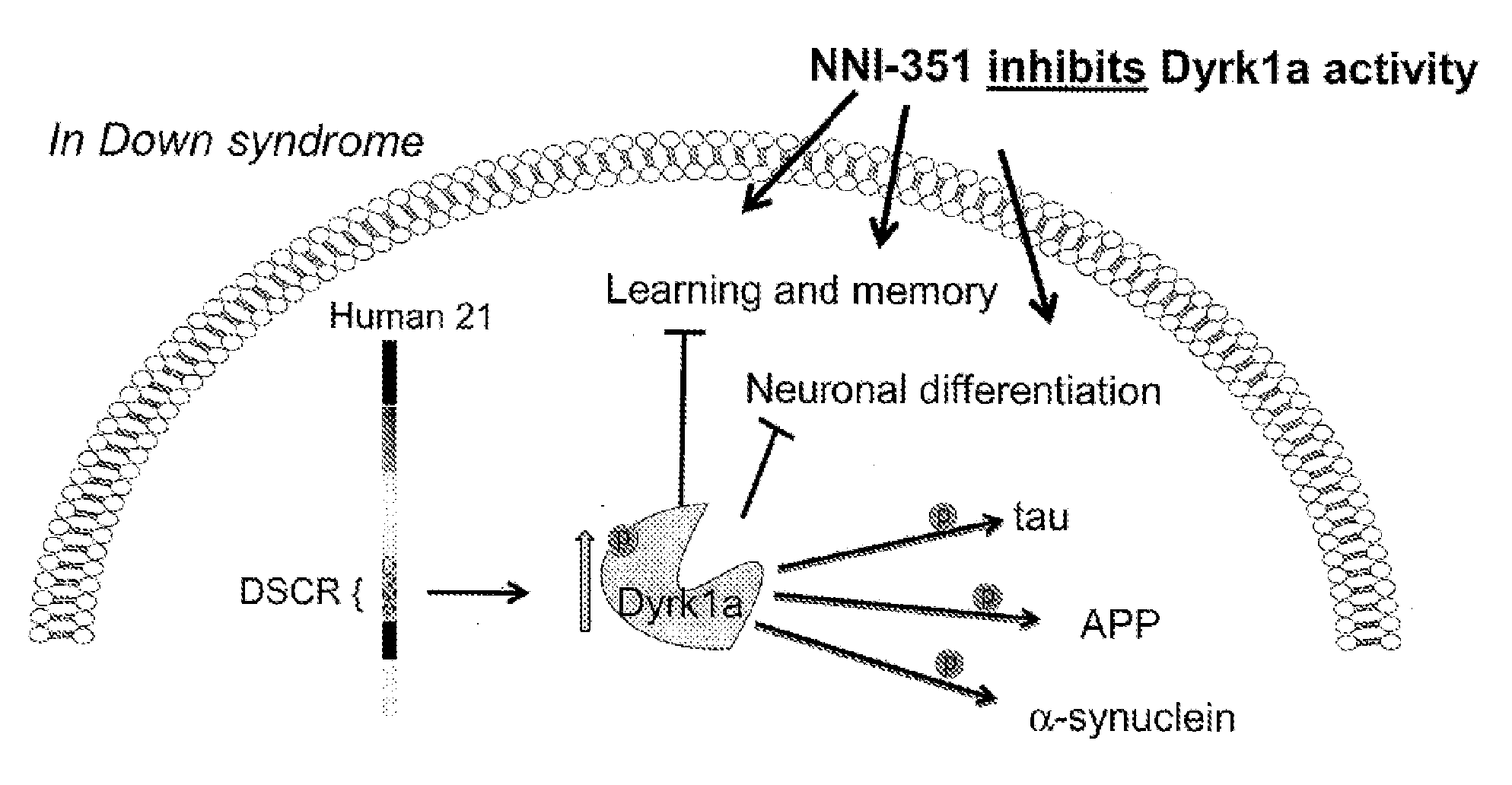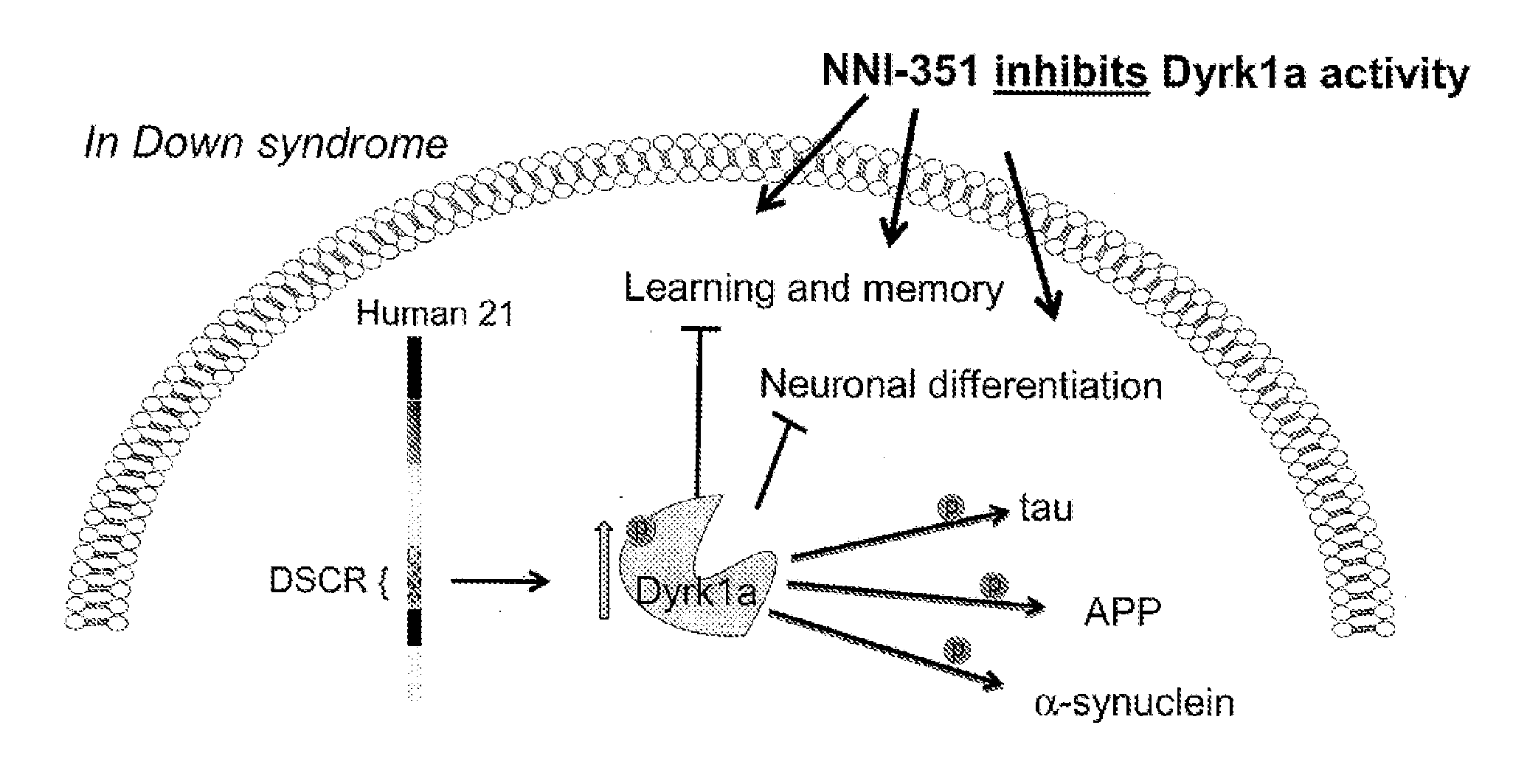Methods and pharmaceutical compositions for treating down syndrome
a technology of down syndrome and compositions, applied in the field of neurology, can solve the problem that there are no therapies for cognitive deficits, and achieve the effect of reducing cognitive impairment and increasing neurogenesis
- Summary
- Abstract
- Description
- Claims
- Application Information
AI Technical Summary
Benefits of technology
Problems solved by technology
Method used
Image
Examples
example 1
Use of Exemplary Compounds in a Mouse Model of Down Syndrome
[0156]
[0157]Ts65Dn mice will be purchased from The Jackson Laboratory at six to eight weeks of age. Though these mutant mice are not perfect models of Down syndrome, the mice have a number of important similarities that provide the best model discovered to date. These mutant mice produce 150% more Dyrk1a protein than normal levels, among other proteins, equating to the gene dosage found in Down syndrome (Dowjat et al., 2007). These animals show a deficit in object recognition paradigm and in Morris water maze compared to other mice models (Fernandez and Garner, 2007) and in hippocampal long-term potentiation (Kleschevnikov et al., 2004), while minimal motoric deficit is observed. Comparatively, these mice have many of the behavioral features observed in Down syndrome (Holtzman et al., 1996). Researchers have been using Ts65Dn mice to better understand the pathology and to elucidate the genes and protein products responsible...
example 2
Screening of Analogs of NNI-351 in a Mouse Model of Down Syndrome
[0160]NNI-351 may not be not optimized for the greatest Dyrk1a inhibition activity, it may be possible to improve the kinase inhibitory activity without diminishing the neurogenesis activity to a significant extent.
[0161]Therefore it is the goal of Example 2 to determine if any analogs of NNI-351 have greater Dyrk1a inhibitory activity. The NNI-351 chemical family was optimized for its ability to promote the greatest neurogenesis activity using human neuronal progenitor cells. Briefly, in order to measure Dyrk1a inhibition, small-molecule analogs of NNI-351 (˜20) at a concentration of 0.1-1 uM will be added to Dyrk1a ELISA kit (Carna Biosciences) and the output will be measured using the Victor Luminometer / Flourescent / UV-Vis plate reader at Neuronascent. The analogs will be compared to NNI-351 inhibition activity. Those analogs with greater inhibitory activity than NNI-351 (minimum of 10% greater) will then be tested f...
example 3
Use of Optimized Analogs of NNI-351 in a Mouse Model of Down Syndrome
[0163]An agent that demonstrates increased Dyrk1a activity (>15% at 1 uM) with a minimal drop in neurogenesis activity (<15%) compared to NNI-351 identified in Example 2 will be resynthesized in quantities appropriate for animal studies (usually around 1 gm) and then administered to mutant Ts65Dn mice at age eight to nine weeks and up to four months of age. The dosing and testing will be carried out as described in Example 1, except that now the more active agent will be administered at 10 mg / kg, ip. If no analog meets the criteria of increased Dyrk1a inhibition with minimal reduction in neurogenesis activity, then the original lead compound, NNI-351, will be retested at a greater or lesser dose. A greater dose would be used if cognition is not significantly improved compared to vehicle controls in Example 1, in order to try to reach normal mouse values in behavioral testing.
PUM
| Property | Measurement | Unit |
|---|---|---|
| pH | aaaaa | aaaaa |
| pH | aaaaa | aaaaa |
| pH | aaaaa | aaaaa |
Abstract
Description
Claims
Application Information
 Login to View More
Login to View More - R&D
- Intellectual Property
- Life Sciences
- Materials
- Tech Scout
- Unparalleled Data Quality
- Higher Quality Content
- 60% Fewer Hallucinations
Browse by: Latest US Patents, China's latest patents, Technical Efficacy Thesaurus, Application Domain, Technology Topic, Popular Technical Reports.
© 2025 PatSnap. All rights reserved.Legal|Privacy policy|Modern Slavery Act Transparency Statement|Sitemap|About US| Contact US: help@patsnap.com



